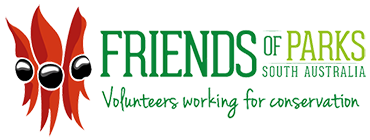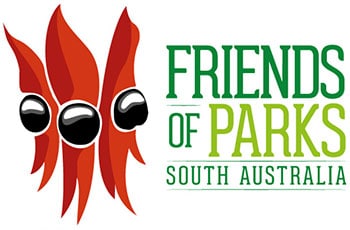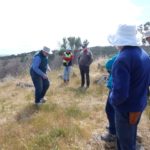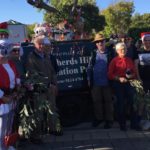Friends of Shepherds Hill Recreation Park
The Friends of Shepherds Hill is a not-for-profit volunteer group formed in 1999 to work with the Department of Environment, Water and Natural Resources, which manages the park, to rehabilitate the park by removing weeds such as olives, broom and boneseed and by limited revegetation with native species grown from locally collected seed.
We hold working bees in the park from 9 am to noon on the first Saturday of each month except January and on the third Saturday of each month from April through October. We warmly welcome new members.
The park
Shepherds Hill Recreation Park is located in the hills face zone in the City of Mitcham between St Marys and Eden Hills about 9 km south of the city of Adelaide with the main entry from Ayliffes Road. Approximately 77 hectares in area, the park is a remnant of Grey Box (Eucalyptus microcarpa) grassy woodland with River Red Gum (Eucalyptus camaldulensis) grassy woodland in the creek lines. There is a network of shared use trails for use by walkers, cyclists and horse riders, a BMX bike riding area near the Ayliffes Road car park and a network of mountain bike trails. The trail network is currently being rationalized by closing off unsustainable and duplicated trails and marking the authorized trails with International standard symbols. When completed, the shared use trails will comprise a Redgum Loop Trail along the Wattiparringga Creek, a Grey Box Loop Trail to the southern end of the park, and a Seaview Loop Trail around the central ridge of the park with great views of the sea and city of Adelaide.
Prior to European settlement, the park was home to the Kaurna people. After settlement, it was taken up for farming and grazing until, as the St. Marys Reserve, it was acquired for public recreation in 1953 and managed by the SA Tourist Bureau as a National Pleasure Resort from 1955 to 1972. In 1972, it was constituted by statute as Shepherds Hill Recreation Park under the National Parks and Wildlife Act 1972.
Friends Of Shepherds Hill Recreation Park
The Friends group was formed in 1999 with the mission to assist the Department Of Environment, Water and Natural Resources (DEWNR) in restoring the vegetation in the park to its natural state by removing the weeds, such as olives, broom and boneseed, and replacing them with native trees and shrubs grown from locally collected seed.
Under the direction of renowned botanist and now Patron, Enid Robertson, the group commenced work in the triangle formed by the boundary with the adjacent National Trust property, Watiparinga, the Viaduct Track and the Ridge Track. This area was selected to provide a buffer between Watiparinga, which had been managed to restore its vegetation for many years, and thus reduce the possibility of weed invasion from Shepherds Hill.
In addition to providing essential plant identification expertise to the group, Enid also promoted the bushcare principles developed by the Bradley sisters of minimal disturbance, working from the good bush outwards and not overclearing, which continue to guide the group today. These principles are also taught by Trees For life and all new members of the group are encouraged to attend a Trees For Life Bush Regeneration Workshop.
The group obtained grant funding to purchase a trailer and tools and also to employ contractors to supplement the group’s efforts, particularly in areas which were too steep for the group to tackle. In 2008, a new management plan was approved for the park that required the preparation of a Vegetation Management Plan. With encouragement from our Liaison Ranger, the group expanded a preliminary plan which had been written in 2006 to record the strategies employed to manage the vegetation at that time, the weed control methods in use and the native and weed species found in the park. The new Vegetation Management Plan, published in 2010, reviewed the vegetation throughout the park, divided the park into 8 vegetation zones, summarized the vegetation in each zone noting the main weeds and also the native plants of conservation significance in each zone, and assigned priorities for work by the Friends group and by contractors. With minor amendments from time to time, this plan has continued to guide the work of the group.
One of the major strategies in the plan, in keeping with the principle of working from the good bush outwards, is to concentrate on removing the olives and other woody weeds that are close to the native trees, particularly the Grey Box trees, and therefore competing with them for water and nutrients, and ignoring those areas of the park where there are lots of weeds, but few native species. As a rough rule of thumb, weeds are considered “close” to native species if they are within 5 metres of them.
Following the completion of primary weed clearance in the triangle area, now Zone 6, priority has been given to woody weed control in the copses of Grey Box in Zone 5, the north facing slope bounded by the Ridge and Viaduct Tracks, and those in Zones 7 and 8, the south facing slope to the south of the Ridge Track, while continuing to follow up from time to time in the triangle area to remove new seedlings.
Considerable revegetation was done in the early 2000’s on both sides of the Ridge Track in the western side of the park in an area with few native trees. The species planted included Grey Box and Drooping Sheoak as well-spaced overstorey species, and Golden Wattle, Kangaroo Thorn and Sticky Hopbush as closer spaced shrubs. These plantings have been highly successful with many trees now up to 4 metres high. In more recent years, revegetation efforts have concentrated on planting amongst the olives in areas of Zones 5 and 7 where there are few native species, the rationale being that we should plant some native trees in these areas so that there will be some there when we eventually get around to dealing with the olives. It also provides an incentive to work on the olives in these areas earlier than we would otherwise do. This year we have planted about 400 trees and shrubs amongst the olives in Zone 7 on the southern side of the Ridge Track, including Grey Box, Drooping Sheoak, Golden Wattle, Sticky Hop Bush and Twiggy Daisy Bush.
The group’s efforts were recognised in 2013 by the award of the Mitcham Council’s Australia Day Award for Excellence in Environmental Achievement.





